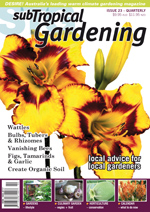Botanic Name: Ruttya fruticosa [Note: unresolved botanical name]
Synonym: Ruttya speciosa; Haplanthera speciosa
Family: Acanthaceae
Common Name: none used in Australia, but known as Jammy Mouth or Jêmbekkie or Rabbit’s Ears overseas.
Benefits: bird attracting (nectar), hedging, tough, easy care. Popular with hummingbirds in the Americas.
Flowers appear sporadic throughout the year, but my garden plants seem to flower most prolifically in subtropical Qld from early summer to beginning of winter. Flower colour variations are red, orange or yellow, so choose the plant with the right flower colour! Interestingly, the same plant in my garden that has ‘brick-red’ flowers in autumn-winter, IS THE SAME plant that has the orange-red flowers in spring-summer … it would appear climate and perhaps nutrients may impact on the intensity of colours within the bloom.
Yellow form known as Ruttya fruticosa ‘Scholesei’.
This plant is perhaps one of the best hedging plants available for subtropical gardens. It flowers occassionally along branches but mostly at the terminal ends. It attracts birdlife, it adapts well to pruning and hedging, is tolerant of a wide range of soils and climate conditions plus rarely gets any pests or diseases (I have never seen any on my plants!).
Native to Africa.


{ 4 comments… read them below or add one }
Hi would like to grow some ruttya fruticosa and am after some sed cheers mick
Hi Mick, I have not seen seeds on my plants for the last three years. Easiest method is by cuttings as I tend to get 80-90% strike rate with a bit of honey used on the cuttings. Also, the only way to source the yellow flower form is by cuttings – it is highly unlikely to produce the same colour by seed (there is always a change with genetics).
Hi Admin
I am facinated to read you use honey on your cuttings. Please advise how this works to help the strike rate and does it work for all plants?
Jill
Hi Jill, freshly cut cuttings are dipped into natural honey. The natural enzymes in honey seem to assist the plant to both seal the wound and stimulate root development. This is a ‘home remedy’ alternative for most gardeners rather than buying rooting hormone, and I am lead to believe some production nurseries also use honey on a range of plants they propagate.
That said, with Ruttya, rooting hormone powder or gel has a higher success with striking.
Honey has not been tried on all plants but it is worth a go.